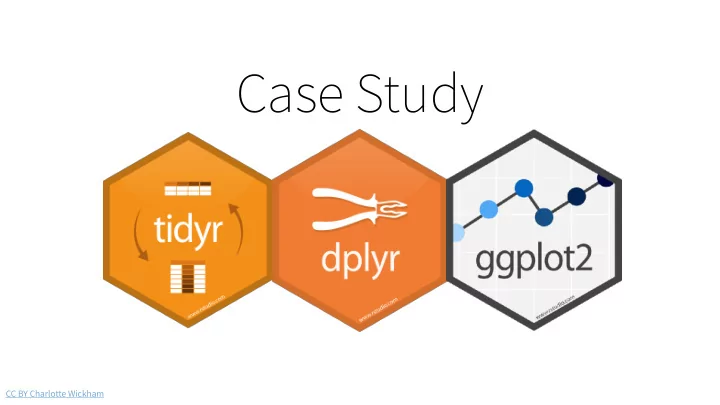

Case Study CC BY Charlotte Wickham
fivethirtyeight Datasets and code from the fivethirtyeight website. (Not o ff icially published by 'FiveThirtyEight'). # install.packages("fivethirtyeight") fivethirtyeight library(fivethiryeight) Adapted from 'Master the tidyverse' CC by RStudio
https://fivethirtyeight.com/features/some- people-are-too-superstitious-to-have-a- baby-on-friday-the-13th/ Can we replicate this plot? CC BY Charlotte Wickham
Your Turn 1 Take a look at US_births_1994_2003 With your neighbour, brainstorm the steps needed to get the data in a form ready to make the plot. CC BY Charlotte Wickham
US_births_1994_2003 %>% filter(year == 1994) %>% ggplot(mapping = aes(x = date, y = births)) + geom_line() CC BY Charlotte Wickham
day_of_week Data required to make the plot day_of_week avg_diff_13* Mon -2.69 Tue -1.38 Wed -3.27 ... ... * using slightly di ff erent data some calculated variable CC BY Charlotte Wickham
Start # A tibble: 3,652 x 6 ? year month date_of_month date day_of_week births <int> <int> <int> <date> <ord> <int> 1 1994 1 1 1994-01-01 Sat 8096 2 1994 1 2 1994-01-02 Sun 7772 ? 3 1994 1 3 1994-01-03 Mon 10142 4 1994 1 4 1994-01-04 Tues 11248 ? ... End ? # A tibble: 7 x 2 day_of_week avg_diff_13 <ord> <dbl> 1 Sun -0.303 ? 2 Mon -2.69 3 Tues -1.38 ? 4 Wed -3.27 5 Thurs -3.01 6 Fri -6.81 7 Sat -0.738 CC BY Charlotte Wickham
One such process Get just the data for the 6th, 13th, and 20th Calculate variable of interest: (For each month/year): Find average births on 6th and 20th Find percentage di ff erence between births on 13th and average births on 6th and 20th Average percent di ff erence by day of the week Create plot CC BY Charlotte Wickham
Your Turn 2 Extract just the 6th, 13th and 20th of each month. ( select(-date) is removing the date column, because it gets in the way later and is redundant). CC BY Charlotte Wickham
US_births_1994_2003 %>% select(-date) %>% filter(date_of_month %in% c(6, 13, 20)) CC BY Charlotte Wickham
One month Two options for arranging the data Option 1 days in rows Option 2 days in cols Which one is tidy? CC BY Charlotte Wickham
Your Turn 3 Which arrangement is tidy? ( Hint: think about our next step "Find the percent di ff erence between the 13th and the average of the 6th and 12th". In which layout will this be easier using our tidy tools?) CC BY Charlotte Wickham
Option 1 Next step, we'd have to write a custom function to summarize these three rows, relying on order, or subsetting to reference dates. NOT TIDY. Option 2 Next step, we can use mutate directly referring to columns for days. TIDY! CC BY Charlotte Wickham
Your Turn 4 Tidy the filtered data to have the days in columns. E.g. CC BY Charlotte Wickham
US_births_1994_2003 %>% select(-date) %>% filter(date_of_month %in% c(6, 13, 20)) %>% spread(date_of_month, births) CC BY Charlotte Wickham
Your Turn 5 Now use mutate() to add columns for: • The average of the births on the 6th and 20th • The percentage di ff erence between the number of births on the 13th and the average of the 6th and 20th (Hint: You need to use backticks ` around the days, e.g. `6`, `13` and `20` to specify the column names) CC BY Charlotte Wickham
US_births_1994_2003 %>% select(-date) %>% filter(date_of_month %in% c(6, 13, 20)) %>% spread(date_of_month, births) %>% mutate( avg_6_20 = (`6` + `20`)/2, diff_13 = (`13` - avg_6_20) / avg_6_20 * 100 ) CC BY Charlotte Wickham
births_diff_13 <- US_births_1994_2003 %>% select(-date) %>% filter(date_of_month %in% c(6, 13, 20)) %>% spread(date_of_month, births) %>% mutate( avg_6_20 = (`6` + `20`)/2, diff_13 = (`13` - avg_6_20) / avg_6_20 * 100 ) CC BY Charlotte Wickham
births_diff_13 %>% ggplot(mapping = aes(day_of_week, diff_13)) + geom_point() CC BY Charlotte Wickham
births_diff_13 %>% filter(day_of_week == "Mon", diff_13 > 10) CC BY Charlotte Wickham
Your Turn 6 Summarize each day of the week to have mean of diff_13 . Then, recreate the fivethirtyeight plot. ( Hint: if you specify a y aesthetic with geom_bar() you'll need to add stat = "identity" as an argument. ( Extra challenge: use a di ff erent summary, and/or another way of visualizing the data) CC BY Charlotte Wickham
US_births_1994_2003 %>% select(-date) %>% filter(date_of_month %in% c(6, 13, 20)) %>% spread(date_of_month, births) %>% mutate( avg_6_20 = (`6` + `20`)/2, diff_13 = (`13` - avg_6_20) / avg_6_20 * 100 ) %>% group_by(day_of_week) %>% summarise(avg_diff_13 = mean(diff_13)) CC BY Charlotte Wickham
births_13_sum <- US_births_1994_2003 %>% select(-date) %>% filter(date_of_month %in% c(6, 13, 20)) %>% spread(date_of_month, births) %>% mutate( avg_6_20 = (`6` + `20`)/2, diff_13 = (`13` - avg_6_20) / avg_6_20 * 100 ) %>% group_by(day_of_week) %>% summarise(avg_diff_13 = mean(diff_13)) CC BY Charlotte Wickham
births_13_sum %>% ggplot(aes(x = day_of_week, y = avg_diff_13)) + geom_bar(stat = "identity") CC BY Charlotte Wickham
Extra Challenges If you wanted to use the US_births_2000_2014 data instead, what would you need to change in the pipeline? How about using both US_births_1994_2003 and US_births_2000_2014 ? Try not removing the date column. At what point in the pipeline does it cause problems? Why? Can you come up with an alternative way to investigate the Friday the 13th e ff ect? Try it out! CC BY Charlotte Wickham
Case Study CC BY Charlotte Wickham
Recommend
More recommend